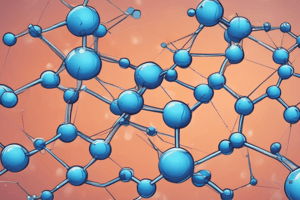Podcast
Questions and Answers
What is the attractive force that holds various constituents together and stabilizes them by the overall loss of energy?
What is the attractive force that holds various constituents together and stabilizes them by the overall loss of energy?
Chemical bonding
In which type of chemical bond do two atoms share electrons, forming a shared electron cloud?
In which type of chemical bond do two atoms share electrons, forming a shared electron cloud?
Covalent bonds
When one atom donates an electron to another atom, resulting in a charged atom (anion) and a neutral atom (a cation), what type of bond is formed?
When one atom donates an electron to another atom, resulting in a charged atom (anion) and a neutral atom (a cation), what type of bond is formed?
Ionic bond
What type of bonds involve the interactions between molecules, such as London dispersion forces and hydrogen bonding?
What type of bonds involve the interactions between molecules, such as London dispersion forces and hydrogen bonding?
What is the branch of chemistry that focuses on the study of matter, its properties, and the changes it undergoes during chemical reactions?
What is the branch of chemistry that focuses on the study of matter, its properties, and the changes it undergoes during chemical reactions?
What is the bond order of a double bond?
What is the bond order of a double bond?
Explain the concept of bond dissociation energy.
Explain the concept of bond dissociation energy.
What is the defining characteristic of a synthesis reaction?
What is the defining characteristic of a synthesis reaction?
Describe the structure of an atom and its components.
Describe the structure of an atom and its components.
What is the primary purpose of the periodic table in chemistry?
What is the primary purpose of the periodic table in chemistry?
Flashcards are hidden until you start studying
Study Notes
Introduction to Physical Chemistry
Physical chemistry is a branch of chemistry that focuses on the study of matter, its properties, and the changes it undergoes during chemical reactions. One of the most fundamental concepts in physical chemistry is chemical bonding, which refers to the formation of a chemical bond between two or more atoms, molecules, or ions to give rise to a chemical compound. This attractive force that holds various constituents (atoms, ions, etc.) together and stabilizes them by the overall loss of energy is known as chemical bonding. The stronger the bonding between the constituents, the more stable the resulting compound will be.
Types of Chemical Bonds
There are several types of chemical bonds, including:
-
Covalent bonds: These bonds occur when two atoms share electrons, forming a shared electron cloud. Covalent bonding is common in organic compounds and semiconductors.
-
Ionic bonds: Ionic bonding occurs when one atom donates an electron to another atom, resulting in a charged atom (anion) and a neutral atom (a cation). Ionic bonding is common in salts and inorganic compounds.
-
Intermolecular bonds: These bonds involve the interactions between molecules, such as London dispersion forces and hydrogen bonding. They are weak and can be affected by various factors like temperature and solvent.
Bond Characteristics
Chemical bonds have certain characteristics that determine their strength and stability. These characteristics include:
-
Lewis structures: These are graphical representations of the electron arrangement in a chemical compound, showing the bonding between atoms.
-
Bond order: This refers to the number of electrons that an atom shares with its neighboring atoms in a bond.
-
Bond polarity: Bond polarity is the tendency of a chemical bond to have an electrical dipole, resulting from the unequal distribution of electrons between the bonding atoms.
-
Bond dissociation energy: This is the energy required to break a chemical bond, which is related to the bond strength and stability of the compound.
Chemical Reactions
Chemical reactions occur when two or more atoms bond together to form molecules or when bonded atoms break apart. These reactions can be classified into two types:
-
Synthesis reactions: These reactions involve the combination of two or more reactants to form a new compound.
-
Decomposition reactions: These reactions involve the breakdown of a compound into its constituent parts.
Introduction to Matter
Matter is composed of various types of particles, such as electrons, protons, and neutrons, which combine to form atoms. Atoms are the basic units of matter and can be classified into two categories:
-
Elementary particles: These are the smallest particles of an element that still have the properties of that element.
-
Atoms: Atoms are composed of a nucleus containing protons and neutrons, with electrons revolving around the nucleus in specific energy levels.
The Periodic Table
The periodic table is a central concept in chemistry, as it organizes elements based on their atomic number, Arrhenius atomic number, and electronic configuration. The periodic table helps chemists understand the properties of elements and their relationships with one another.
Conclusion
Physical chemistry is a vast field that encompasses various concepts and phenomena, from atomic structure to chemical bonding and reactions. Understanding these concepts is crucial for explaining the behavior of matter and predicting the outcomes of chemical reactions.
Studying That Suits You
Use AI to generate personalized quizzes and flashcards to suit your learning preferences.




